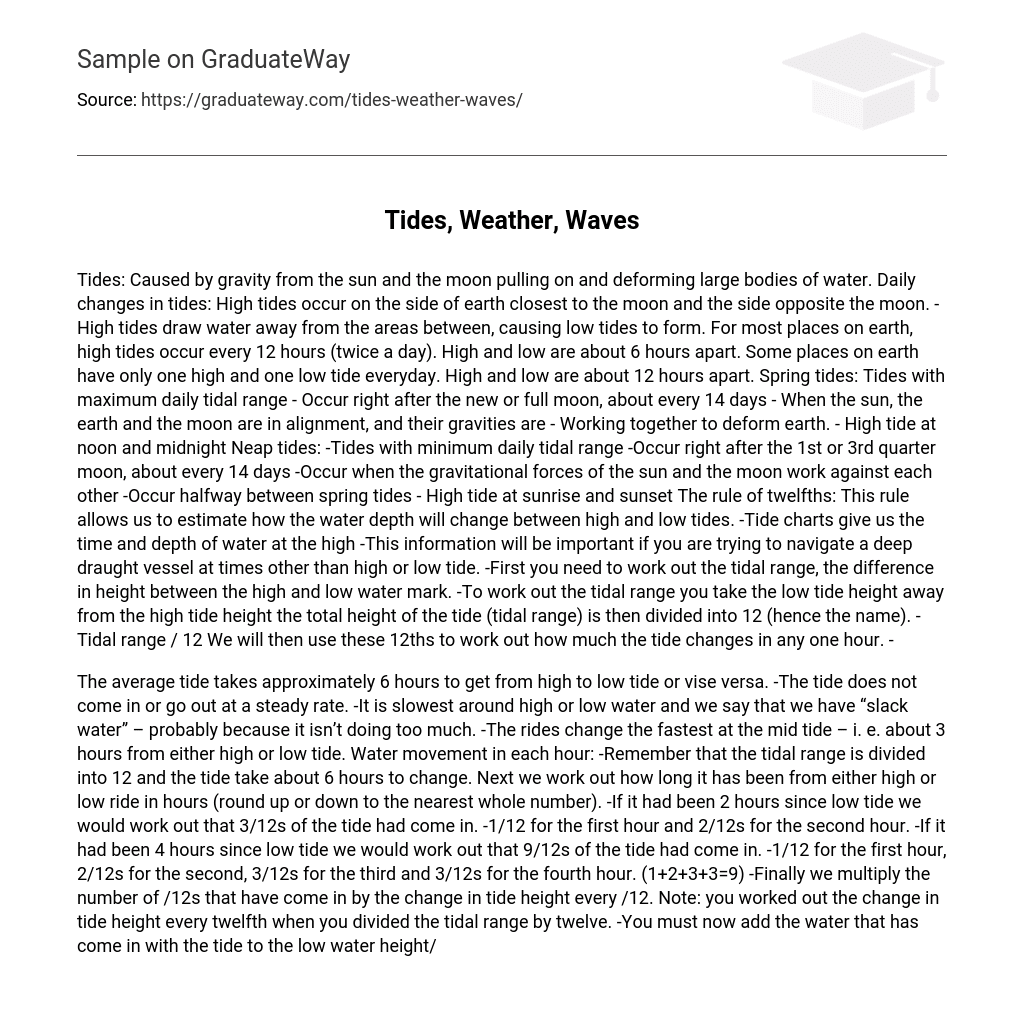Tides: Caused by gravity from the sun and the moon pulling on and deforming large bodies of water. Daily changes in tides: High tides occur on the side of earth closest to the moon and the side opposite the moon. -High tides draw water away from the areas between, causing low tides to form. For most places on earth, high tides occur every 12 hours (twice a day). High and low are about 6 hours apart. Some places on earth have only one high and one low tide everyday. High and low are about 12 hours apart. Spring tides: Tides with maximum daily tidal range – Occur right after the new or full moon, about every 14 days – When the sun, the earth and the moon are in alignment, and their gravities are – Working together to deform earth. – High tide at noon and midnight Neap tides: -Tides with minimum daily tidal range -Occur right after the 1st or 3rd quarter moon, about every 14 days -Occur when the gravitational forces of the sun and the moon work against each other -Occur halfway between spring tides – High tide at sunrise and sunset The rule of twelfths: This rule allows us to estimate how the water depth will change between high and low tides. -Tide charts give us the time and depth of water at the high -This information will be important if you are trying to navigate a deep draught vessel at times other than high or low tide. -First you need to work out the tidal range, the difference in height between the high and low water mark. -To work out the tidal range you take the low tide height away from the high tide height the total height of the tide (tidal range) is then divided into 12 (hence the name). -Tidal range / 12 We will then use these 12ths to work out how much the tide changes in any one hour. –
The average tide takes approximately 6 hours to get from high to low tide or vise versa. -The tide does not come in or go out at a steady rate. -It is slowest around high or low water and we say that we have “slack water” – probably because it isn’t doing too much. -The rides change the fastest at the mid tide – i. e. about 3 hours from either high or low tide. Water movement in each hour: -Remember that the tidal range is divided into 12 and the tide take about 6 hours to change. Next we work out how long it has been from either high or low ride in hours (round up or down to the nearest whole number). -If it had been 2 hours since low tide we would work out that 3/12s of the tide had come in. -1/12 for the first hour and 2/12s for the second hour. -If it had been 4 hours since low tide we would work out that 9/12s of the tide had come in. -1/12 for the first hour, 2/12s for the second, 3/12s for the third and 3/12s for the fourth hour. (1+2+3+3=9) -Finally we multiply the number of /12s that have come in by the change in tide height every /12. Note: you worked out the change in tide height every twelfth when you divided the tidal range by twelve. -You must now add the water that has come in with the tide to the low water height/ this gives you the total height of the tide. -Note: if you worked from a high tide Question: What is the height of the tide on July 12th at 5:00pm? Low Water 1405 – 0. 37m High Water 2039 – 2. 02m 1. 65 Tidal range = 0. 37-2. 02 = 1. 65 0. 1375 Weather What makes weather? -Is energy from the sun evenly distributed? -Sun heating the earth -Deficits and excess Unequal heating of the each! -Thus unequal energy is moved and distributed to other places on earth -Heated air warms, expands, become less dense, and rises, causing local low pressure -2.
Air from mid altitudes moves towards equator -3. Air above equator spreads out towards poles. -4. Cooled air falls at poles creating local high pressure Wind patterns are a balance of 3 forces 1. The pressure gradient force causes wind to blow from high pressure toward low pressure. 2. The Coriolis force causes wind to be deflected to the right of the motion in the northern hemisphere. . Friction, which slows the wind Coriolis (Southern hemisphere – air moves to the left of the initial motion) -Highs – counterclockwise rotation -Low – clockwise rotation. Cold front -Cold, dry air replaces warm air -Following a cold front, temperatures drop dramatically. -Precipitation can occur along the front line. Including thunderstorms. Warm Front -Warm moist air replaces cool dry air. -Following a warm front, temperatures increase. -Light precipitation can occur along the front line. Stationary front A stationary front occurs when a warm or cold front stops moving. -Noticeable temperature and win shifts occur when traveling across the front line -Once the stationary front starts moving again, it becomes warm or cold. Occluded front -Occurs when a cold front catches up to a warm front. A cold front travels faster than a warm front. – Changes in temperature, humidity, and winds occur with passage of an occluded front. (See diagram to the left. ) Isobars -Isobar: connects areas of equal pressure bar comes from barometric pressure -Close together= stronger winds.





